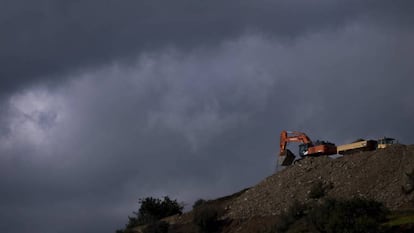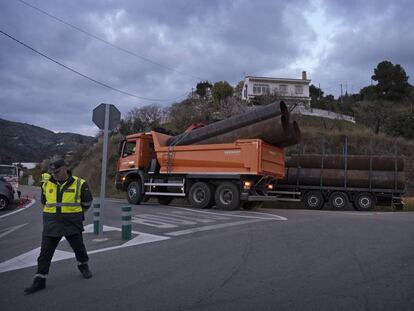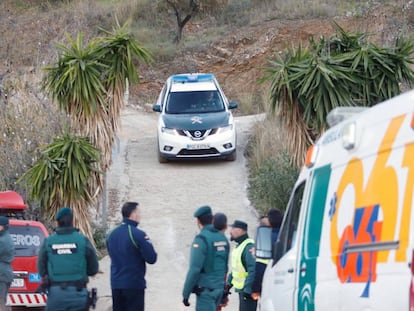Julen rescue: “No one doubts we will find him and we hope he will be alive”
Tensions are running high as the rescue effort to save the two-year-old who fell down a 100-meter-deep borehole in Málaga on Sunday enters its sixth day
The rescue team tasked with finding a Spanish toddler who fell down a borehole on Sunday will today begin drilling a vertical tunnel to reach the point where the two-year-old is thought to be trapped.
Julen Roselló was playing on a relative’s property in Totalán, in Málaga province, when he apparently fell into a 100-meter hole with a diameter of no more than 30 centimeters that had been covered with loose rocks.
The head of the rescue effort, Ángel García Vidal, told Europa Press that drilling of the parallel tunnel is expected to start “at midday or early in the afternoon.”
At 8am on Friday morning the heavy machinery that will be used to bore two holes parallel to the one into which Julen fell arrived at the local train station. By Friday afternoon, the machine was slowly making its way to the site, a difficult task given the scale of the truck and the uneven terrain.

The complexity of the operation has turned into a civil engineering feat that under normal circumstances would take months to plan and complete. But the team in Totalán is hoping to manage it in hours. They are also facing the added difficult of rain, which is forecast to fall over the next days.
“All our effort is aimed at making the length of time of the work as short as possible,” said García Vidal.
“We are not going to stop even for a minute until he is rescued from there,” said María Gámez, the central government’s deputy delegate in Málaga. “No one on the team doubts that we will find him and we hope and trust he will be alive,” she added.
Next steps
The rescue operation is aiming to bore two vertical tunnels parallel to the borehole where Julen is trapped. Initially only one was going to be built but the team believes a second will increase the likelihood of finding the two-year-old.
Before the tunnels can be built, the ground needs to be smoothed to allow the machinery to work safely. Once the tunnel is 30 meters deep, the team will open a 1.2 meter wide space and dig a further 50 meters. It is unknown how long this will take. “In ideal conditions, it would take between 12 and 16 hours but this could vary here because of the circumstances presented by the terrain,” García Vidal explained.
This work will allow the team to reach below the blockage, which is 71 meters depth, and where Julen is expected to be.
“The pressure is immense”
A rescue team of miners from the northern region of Asturias will be in charge of bringing the toddler to safety once he is found. The elite group, known as the Asturian Miners Lifesaving Brigade, arrived in Totalán on Tuesday after being flown in on a military plane.
We are not going to stop even for a minute
Government deputy delegate María Gámez
Once the parallel tunnel is finished and properly piped to stop it from collapsing and from water from getting in, a miner will be hoisted down to connect the tunnel with the borehole and check whether Julen is there. If he isn’t found, the team will bore further down to 100 meters.
“These boreholes tend to have subterranean water currents below, they can even have hollows,” explained one of the miners. “There could even be a cave below.”
Santiago Suárez García, the former head of the Asturian Miners Lifesaving Brigade, told EL PAÍS that in these situations, “the pressure is immense.” But he said the rescuers were well prepared, explaining that they are used to training drills where they are given 30 minutes to escape smoke-filled labyrinths.
Social media response
#mimanoajulen #2ESOC_IESCJMalaga pic.twitter.com/3RhGagYGXI
— IES Ciudad Jardín Málaga (@iescjmalaga) January 18, 2019
Social media users have rushed to share their support for the two-year-old Julen and his family. Using the hashtag #mimanoajulen (I give my hand to Julen), thousands of people had shared photos of their hands and messages of solidarity.
English version by Melissa Kitson.
Tu suscripción se está usando en otro dispositivo
¿Quieres añadir otro usuario a tu suscripción?
Si continúas leyendo en este dispositivo, no se podrá leer en el otro.
FlechaTu suscripción se está usando en otro dispositivo y solo puedes acceder a EL PAÍS desde un dispositivo a la vez.
Si quieres compartir tu cuenta, cambia tu suscripción a la modalidad Premium, así podrás añadir otro usuario. Cada uno accederá con su propia cuenta de email, lo que os permitirá personalizar vuestra experiencia en EL PAÍS.
¿Tienes una suscripción de empresa? Accede aquí para contratar más cuentas.
En el caso de no saber quién está usando tu cuenta, te recomendamos cambiar tu contraseña aquí.
Si decides continuar compartiendo tu cuenta, este mensaje se mostrará en tu dispositivo y en el de la otra persona que está usando tu cuenta de forma indefinida, afectando a tu experiencia de lectura. Puedes consultar aquí los términos y condiciones de la suscripción digital.
More information
Archived In
Últimas noticias
Most viewed
- Reinhard Genzel, Nobel laureate in physics: ‘One-minute videos will never give you the truth’
- Oona Chaplin: ‘I told James Cameron that I was living in a treehouse and starting a permaculture project with a friend’
- Pablo Escobar’s hippos: A serious environmental problem, 40 years on
- Charles Dubouloz, mountaineering star, retires at 36 with a farewell tour inspired by Walter Bonatti
- Why we lost the habit of sleeping in two segments and how that changed our sense of time












































